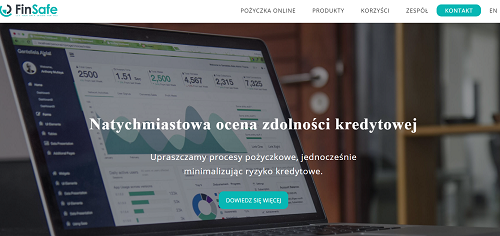finsafe.io opinie klientów firmy finsafe forum pożyczka

Kto może starać się o pożyczkę?
Kredytobiorca:
-powinien być pełnoletni
-nie może mieć już otwartej kredytu w tej instytucji pożyczkowej,
-nie może posiadać niezwróconych kredytów w firmie,
-koniecznie musi posiadać aktywny telefon komórkowy,
-musi być obywatelem Polski,
-musi posiadać zdolność do oddania pożyczek powstałych w następstwie otrzymania pożyczki gotówkowej od finsafe.io
-musi podpisać umowę z firmą kredytową,
-musi posiadać stałe źródło dochodu,
-powinien posiadać ważny Dowód Tożsamości,
-powinien mieć osobiste funkcjonujące konto
Czy mogę posiadać kilka kredytów w finsafe za jednym razem?
W finsafe wolno posiadać wyłącznie jedno aktywne zobowiązanie. Po jego spłacie wolno strać się o następną chwilówkę na dokument tożsamości. finsafe.io ceni solidnych klientów oferując im porządne warunki przy następnych kredytach.
Pozyskałem kredyt w www.finsafe.io na co mogę ją przeznaczyć?
Kredyt gotówkowy może być przeznaczona na każdy cel. Nie ma wymogu wcześniej informować na co chcemy przeznaczyć pieniądze z kredytu.
Ile wynosi RRSO?
Faktyczna Roczna Stopa Oprocentowania którą opłacamy za dany kredyt, czy pożyczkę w skali roku.
Rzeczywista Roczna Stopa Oprocentowania jest zmienna.
Czy mogę odstąpić od umowy pożyczki gotówkowej?
Gdy klient nie jest zadowolony z detali podpisanej umowy pożyczki, ma prawo odstąpić od niej w czasie 14 dni od momentu, kiedy dokument wszedł w życie. Żeby to zrobić, wystarczy dostarczyć stosowne oświadczenie. Ma wtedy 30 dni by oddać pożyczoną kwotę wraz z odsetkami naliczonymi do momentu odstąpienia od umowy pożyczki. Dokument z nadrukowany wzorem oświadczenia ma obowiązek wręczyć pożyczkodawca w chwili udzielenia pożyczki. Taki wzór może być możliwy do znalezienia również na stronie internetowej pożyczkodawcy. W takim wypadku należy jedynie go wydrukować. W wypadku. gdy przegapimy termin oddania pożyczki, oświadczenie uważa się za nieważne. Zaś jeśli ponieśliśmy jakiekolwiek koszty w momencie zawierania umowy, druga strona ma obowiązek się z nami rozliczyć.,
Mam kredyty gotówkowe w innych parabankach czy mogę się starać o kredyt?
Tak, to czy zostanie państwu przyznana chwilówka postanowi pożyczkodawca stąd nic nie ryzykujesz możesz dostarczyć wniosek a ona oceni twoją zdolność kredytową i czy przyznać chwilówkę lub odmówić jego przyznania.
Czy finsafe.io dzwoni do pracodawcy?
Nie, firma finansowa w żadnym przypadku nie telefonuje do zakładu pracy. Twoje dane personalne są bardzo dobrze przechowywane i nie są stosowane w celu telefonowania do Twoich pracodawców.,
Czy chwilówkę można oddać przed terminem?
Oczywiście istnieje szansa wcześniejszej spłaty zaciągniętej w finsafe.io pożyczki. Zgodnie z regulacją o pożyczkach konsumenckich, w takiej sytuacji, na wniosek klienta zostaje przekazana nienależna finsafe proporcjonalna porcja należności. Ażeby dostarczyć taki wniosek należy skontaktować się z Działem Obsługi Klienta.,
Z jakiego powodu mój wniosek o pożyczkę został odrzucony?
Niestety, nie możemy udzielić Ci kredytu gotówkowego, jeśli:
-posiadasz mniej niż 18 lat
-nie jesteś mieszkańcem RP,
-nie masz funkcjonującego telefonu komórkowego,
-nie masz ważnego DO,
-twój formularz rejestracyjny posiada błędy,
-nie podpisałeś umowy z kredytodawcą,
-nie posiadasz konta,
-posiadasz niespłaconą dotychczasową pożyczkę w www.finsafe.io
Kiedy gotówka będzie na moim koncie?
Środki z pożyczki otrzymasz nawet w ciągu kilku godzin wyliczanych od momentu uzyskania pozytywnej weryfikacji zdolności pożyczkowej, pod założeniem, iż posiadasz konto w banku, na jakie ma zostać wpłacona chwilówka w współpracującym z kredytodawcą banku.
Czy finsafe.io sprawdza bazy KRD?
Krajowy Rejestr Długów to instytucja, zbierająca informacje dotyczące sytuacji finansowej konsumentów jak też instytucji biznesowych niezależnie od ich wielkości. Dane dotyczące dłużników są przekazywane do KRD przez przedsiębiorców, gminy i ich oddziały oraz przez osoby fizyczne, tytuł wykonawczy. KRD pełni rolę platformy wymiany danych gospodarczych. Dzięki KRD każdy może zdobyć informacje o nieuczciwych klientach, co może uchronić przed doznaniem strat materialnych. Ponadto KRD prowadzi program „Rzetelna Firma”, wspierający rzetelne i uczciwe firmy.
TAK – firma pożyczkowa weryfikuje informacje w bazy KRD,
Czy pożyczka finsafe przekazuje wiadomości o chwilówce do KRD, BIK, ERIF, BIG? Czy wpisuje do takich rejestrów jak KRD, ERIF, BIK, BIG?
Instytucja przy potwierdzaniu klienta używa określonych baz oraz spisów dłużników wobec tego posiada możliwość dodawania informacji o nierzetelnych klientach do wyżej wyszczególnionych baz.
Czy kredyt finsafe sprawdza historię w BIK?
BIK zostało założone w roku 1997 za sprawą banków i Związku Banków Polskich. Biuro Informacji Kredytowej to największa w kraju baza informacji o podmiotach indywidualnych, jak i firmach. Oprócz danych w zakresie kredytów bankowych, BIK posiada dane o pożyczkach krótkoterminowych. BIK cechuje duża sprawdzalność. utrwalone w Biurze informacji kredytowej informacje z jednej strony mają dobry aspekt, szczególnie dla klientów mających pozytywnądobrą historię kredytową, z drugiej negatywną dla osób, którzy posiadają zaległe zobowiązania finansowe. BIK ogólnie jest postrzegane jako znacząca instytucja, służąca rzeczowej ocenie sytuacji i wspomagająca działania finansowe. Wykorzystanie danych z BIK jest bardzo znaczące. Możliwość otrzymania raportu BIK jest możliwa za odpowiednia kwotą.
TAK – kredytodawca sprawdza informacje w historię w BIK
Czy firma przegląda historie w BIG Infomonitor?
BIG InfoMonitor jest rejestrem, w którym umieszczone są wszystkie informacje gospodarcze uzyskiwane, kumulowane, a także upowszechniane przez Biuro Informacji Gospodarczej InfoMonitor S.A. Jednakże w rejestrze dłużników BIG InfoMonitor bierze pod uwagę tylko negatywne informacje gospodarcze. Ponadto, tworzy on element Rejestru BIK.
Do opisywanego ewidencji można trafić, gdy spełni się poniższe uwarunkowania:
– wysokość zadłużenia wyniesie przynajmniej 200 zł,
– opóźnienie w zakresie uiszczenia wierzytelności przekroczy 60 dni,
– od otrzymania od pożyczkodawcy informacji o intencji przeprowadzenia wpisu do BIK InfoMonitor upłynęło co najmniej 30 dni.
Opóźnienie w spłacie kredytu gotówkowego – Windykacja
Jeśli nie uda nam się zapłacić pożyczki w określonym terminie albo zalegamy ze zapłaceniem rat kredytu po pewnym terminie nasza zobowiązanie zostanie przekazana do windykacji. Windykacja polega na takich działaniach, na skutek których dłużnik zapłaci swoją zaległość a jeśli nie – sprawa zostanie przekazana do sądu i następnie do komornika. Zanim tak się stanie jest kilka możliwości działania ze strony dłużnika. Można zawrzeć umowę z finsafe.pl o rozłożenie zobowiązania na mniejsze raty co jest bardzo dogodnym rozwiązaniem zarówno dla pożyczkobiorcy, jak i dla instytucji finansowej. Ten pierwszy nie ponosi na dodatkowe koszty komornicze, ten drugi- otrzymuje swoje pieniądze, wolniej, ale jednak.
finsafe opinie
Wszystkie opinie można zobaczyć w komentarzach. Nowe opinie dotyczące www.finsafe.io prosimy także zamieszczać niżej w komentarzach pod postem. Dziękujemy za wszelkie zamieszczone opinie. Jednocześnie prosimy o zachowanie odpowiedniego pułapu dyskusji również nie używanie wulgaryzmów takie komentarze będą wyrzucane a użytkownicy banowani.